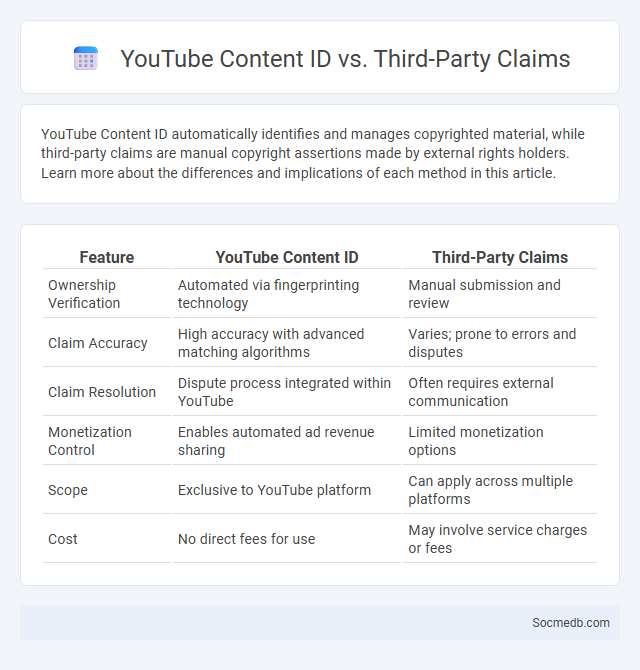
Photo illustration: YouTube Content ID vs Third-Party Claims
YouTube Content ID automatically identifies and manages copyrighted material, while third-party claims are manual copyright assertions made by external rights holders. Learn more about the differences and implications of each method in this article.
Table of Comparison
| Feature | YouTube Content ID | Third-Party Claims |
|---|---|---|
| Ownership Verification | Automated via fingerprinting technology | Manual submission and review |
| Claim Accuracy | High accuracy with advanced matching algorithms | Varies; prone to errors and disputes |
| Claim Resolution | Dispute process integrated within YouTube | Often requires external communication |
| Monetization Control | Enables automated ad revenue sharing | Limited monetization options |
| Scope | Exclusive to YouTube platform | Can apply across multiple platforms |
| Cost | No direct fees for use | May involve service charges or fees |
Understanding YouTube Content ID
YouTube Content ID is a powerful digital rights management system that automatically scans and identifies copyrighted material within uploaded videos. Rights holders submit reference files that enable the system to detect matches and enforce policies such as monetization, tracking, or blocking infringing content. This technology helps protect creators' intellectual property while maintaining platform integrity by managing millions of video uploads daily.
What are Third-Party Claims on YouTube?
Third-party claims on YouTube occur when a content owner asserts copyright rights over materials included in a video, such as music, clips, or images. These claims can result in monetization being directed to the rights holder, video blocking, or removal depending on the claim type and agreement. YouTube's Content ID system automatically detects and manages these claims to protect intellectual property rights of third parties.
Key Differences: Content ID vs Third-Party Claims
Content ID is an automated system used by platforms like YouTube to identify and manage copyrighted content, allowing rights holders to monetize, track, or block videos containing their material. Third-party claims occur when external individuals or organizations manually submit copyright claims on specific content, often requiring individual review and resolution. Understanding the distinction between Content ID and third-party claims helps you effectively manage your content rights and avoid potential copyright strikes.
How Content ID Detects Copyrighted Material
Content ID employs advanced audio and video fingerprinting technologies to scan uploaded media against a vast database of copyrighted works maintained by rights holders. The system analyzes unique digital signatures within the content, enabling real-time identification of matches even in altered or partial clips. Copyright holders are then empowered to block, monetize, or track the matched content according to their pre-set policies.
The Role of Manual vs Automated Claims
Manual claims on social media enable personalized responses, fostering trust and enhancing customer engagement through tailored communication. Automated claims leverage AI-powered tools and algorithms to process high volumes efficiently, ensuring rapid resolution and consistent messaging across platforms. Balancing manual intervention with automation optimizes accuracy and scalability in managing social media claims.
Monetization Implications: Content ID vs Third-Party Claims
Monetization implications vary significantly between Content ID and third-party claims on social media platforms, where Content ID allows copyright holders to automatically identify and monetize or block videos using their content. Your revenue potential can be directly affected by how these claims are managed, as Content ID claims often enable sharing ad revenue, whereas third-party claims might result in demonetization or video removal. Understanding the distinction between these systems is crucial for maximizing earnings while maintaining compliance with platform policies.
Dispute Processes for Content ID and Third-Party Claims
The Content ID system on social media platforms efficiently manages third-party claims by automatically identifying copyrighted material in user-uploaded content. Dispute processes allow creators to challenge claims through a structured review system, ensuring fair resolution based on copyright ownership and usage rights. Timely responses and transparent policies help minimize conflicts and protect both rights holders and content creators.
Impact on Channel Reputation and Video Visibility
Social media platforms significantly influence your channel reputation by shaping audience perception through engagement metrics such as likes, comments, and shares. Increased user interaction boosts algorithmic favorability, enhancing video visibility across networks like YouTube, Facebook, and Instagram. Consistently positive engagement signals improve search rankings and attract a broader audience, solidifying your channel's credibility and growth potential.
Best Practices to Avoid Claims and Strikes
To minimize claims and strikes on social media platforms, consistently use original content or properly licensed material, including images, music, and videos. Implement strict monitoring protocols to promptly identify and remove infringing or inappropriate content, ensuring compliance with platform guidelines. Maintain thorough documentation of permissions and content sources to support any necessary disputes or appeals.
Future of Copyright Enforcement on YouTube
The future of copyright enforcement on YouTube is increasingly shaped by AI-powered content recognition and automated takedown systems. Advanced machine learning algorithms will enable real-time detection of copyrighted material, enhancing the accuracy and speed of content identification. These innovations aim to balance creators' rights with fair use policies, reducing false claims and supporting a more transparent platform ecosystem.
 socmedb.com
socmedb.com